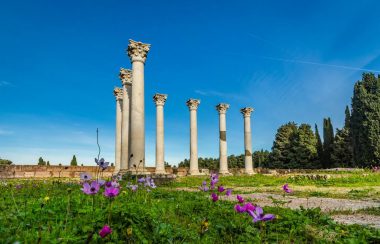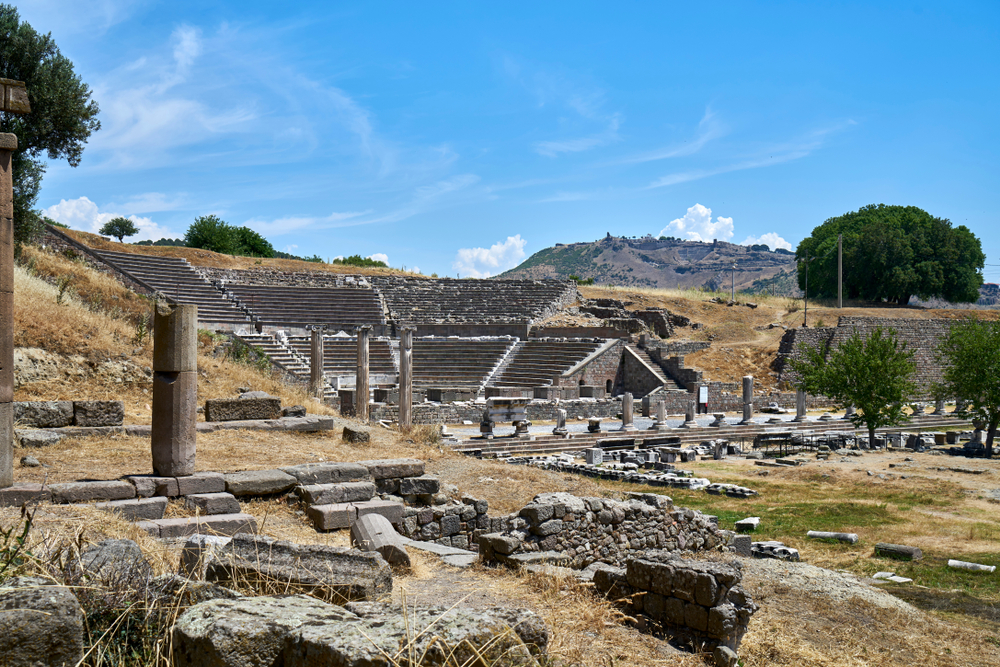The Asklepieion temple complex is one of the most famous sights on the Greek island of Kos. The ancient sanctuary is located about four kilometers southwest of the island’s capital on a wooded hill. Asklepieion is located 100 meters above sea level and is surrounded by cypress trees. The temple complex was discovered in 1901 and has been a popular tourist destination ever since. Below you can learn more about the architecture and history of Asklepieion in Kos.
What does Asklepieion mean?
The Asklepieion is a place where the Greek god Asclepius was worshipped. He was the god of healing, which is why the medical craft was actually practiced and taught in the temple complexes. In ancient Greece , there were around 300 of these temples. The Asklepieion on Kos is one of the most important sites and is well archaeologically documented. The temple complex, built on several levels, is one of the most famous sights on Kos.
The construction of the temple complex

The buildings of the temple complex are located on a slope and were laid out on several terraces. The different levels are connected by imposing marble staircases. On the lowest terrace there are porticoes from the first century. Attached to it were the treatment rooms of famous ancient doctors, such as Gaius Stertinius, the personal physician of the Roman Emperor Claudius. There are also two underground rooms that were probably used for isolation purposes in the event of contagious diseases. The middle level of the temple complex was built in the fourth century BC. Erected. There are medicinal baths that were fed by a spring of Mount Dikeos. Training buildings for doctors and a museum of medical history have also been found on the middle level. In addition, there are several Ionian-style temple buildings on this level, as well as a temple of Apollo.
The south side of the temple
On the south side of the lower terrace, there are arched niches along a retaining wall. They once housed statues of gods. The water of a fountain flows from one of the niches. In the middle, the retaining wall is interrupted by a large open staircase, which leads to the middle level of the complex. This is where the oldest part of the complex is located. It includes an altar and a small temple building in the Ionian style. Both date from the fourth century BC. About 100 years later, a semicircular exedra and the Temple of Apollo were added.
Marble temple in Doric style
On the top level of Asklepieion was a spacious marble temple in the Doric style. A copy of this temple can be seen in Epidaurus. A Byzantine altar indicates that the temple was later used as a church. From the top level you can enjoy a magnificent view over Kos. The opposite Turkish coast with the seaside resort of Bodrum and ancient Halicarnassus can also be seen.
The Temple of Apollo in the Asclepieion of Kos
The Corinthian-style Temple of Apollo dates back to the second century BC. A 38-meter-wide staircase leads to it, because the temple is 11 meters higher than the third level. The Doric-style temple was decorated with statues of Asclepius and his daughter Hygieia. In Byzantine times, the temples of Asclepius and Apollo were converted into Christian churches. In the temple of Asclepius you can find remains of an altar with Christian inscriptions.
The Great Temple of Asclepius
The main temple, dedicated to Asclepius, consisted of several columned halls. Behind it were rooms for visitors and patients. Via a staircase, they reached a pine and cypress forest behind it. The forest was dedicated to Apollo and was considered a sacred site. According to tradition, Asklepieion of Kos also included a stadium and a theatre, which have not been discovered to this day.
How to get to Asklepieion on Kos
From Kos Town, turn right towards Platani. There you turn right again and after a few kilometers you reach Asklepieion. A large car park is available for visitors.


